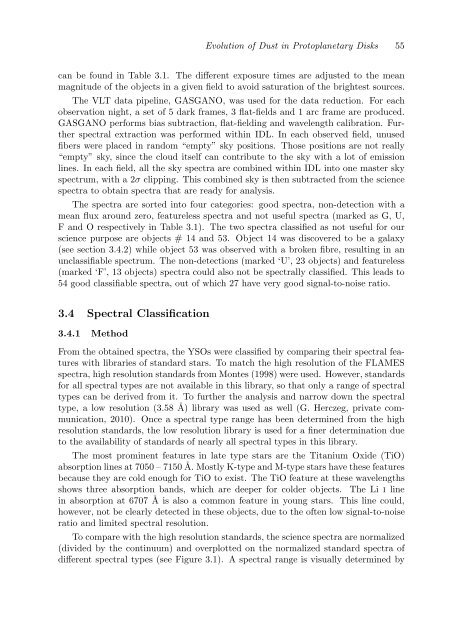Observational Constraints on The Evolution of Dust in ...
Observational Constraints on The Evolution of Dust in ...
Observational Constraints on The Evolution of Dust in ...
You also want an ePaper? Increase the reach of your titles
YUMPU automatically turns print PDFs into web optimized ePapers that Google loves.
Evoluti<strong>on</strong> <strong>of</strong> <strong>Dust</strong> <strong>in</strong> Protoplanetary Disks 55<br />
can be found <strong>in</strong> Table 3.1. <strong>The</strong> different exposure times are adjusted to the mean<br />
magnitude <strong>of</strong> the objects <strong>in</strong> a given field to avoid saturati<strong>on</strong> <strong>of</strong> the brightest sources.<br />
<strong>The</strong> VLT data pipel<strong>in</strong>e, GASGANO, was used for the data reducti<strong>on</strong>. For each<br />
observati<strong>on</strong> night, a set <strong>of</strong> 5 dark frames, 3 flat-fields and 1 arc frame are produced.<br />
GASGANO performs bias subtracti<strong>on</strong>, flat-field<strong>in</strong>g and wavelength calibrati<strong>on</strong>. Further<br />
spectral extracti<strong>on</strong> was performed with<strong>in</strong> IDL. In each observed field, unused<br />
fibers were placed <strong>in</strong> random “empty” sky positi<strong>on</strong>s. Those positi<strong>on</strong>s are not really<br />
“empty” sky, s<strong>in</strong>ce the cloud itself can c<strong>on</strong>tribute to the sky with a lot <strong>of</strong> emissi<strong>on</strong><br />
l<strong>in</strong>es. In each field, all the sky spectra are comb<strong>in</strong>ed with<strong>in</strong> IDL <strong>in</strong>to <strong>on</strong>e master sky<br />
spectrum, with a 2σ clipp<strong>in</strong>g. This comb<strong>in</strong>ed sky is then subtracted from the science<br />
spectra to obta<strong>in</strong> spectra that are ready for analysis.<br />
<strong>The</strong> spectra are sorted <strong>in</strong>to four categories: good spectra, n<strong>on</strong>-detecti<strong>on</strong> with a<br />
mean flux around zero, featureless spectra and not useful spectra (marked as G, U,<br />
F and O respectively <strong>in</strong> Table 3.1). <strong>The</strong> two spectra classified as not useful for our<br />
science purpose are objects # 14 and 53. Object 14 was discovered to be a galaxy<br />
(see secti<strong>on</strong> 3.4.2) while object 53 was observed with a broken fibre, result<strong>in</strong>g <strong>in</strong> an<br />
unclassifiable spectrum. <strong>The</strong> n<strong>on</strong>-detecti<strong>on</strong>s (marked ‘U’, 23 objects) and featureless<br />
(marked ‘F’, 13 objects) spectra could also not be spectrally classified. This leads to<br />
54 good classifiable spectra, out <strong>of</strong> which 27 have very good signal-to-noise ratio.<br />
3.4 Spectral Classificati<strong>on</strong><br />
3.4.1 Method<br />
From the obta<strong>in</strong>ed spectra, the YSOs were classified by compar<strong>in</strong>g their spectral features<br />
with libraries <strong>of</strong> standard stars. To match the high resoluti<strong>on</strong> <strong>of</strong> the FLAMES<br />
spectra, high resoluti<strong>on</strong> standards from M<strong>on</strong>tes (1998) were used. However, standards<br />
for all spectral types are not available <strong>in</strong> this library, so that <strong>on</strong>ly a range <strong>of</strong> spectral<br />
types can be derived from it. To further the analysis and narrow down the spectral<br />
type, a low resoluti<strong>on</strong> (3.58 Å) library was used as well (G. Herczeg, private communicati<strong>on</strong>,<br />
2010). Once a spectral type range has been determ<strong>in</strong>ed from the high<br />
resoluti<strong>on</strong> standards, the low resoluti<strong>on</strong> library is used for a f<strong>in</strong>er determ<strong>in</strong>ati<strong>on</strong> due<br />
to the availability <strong>of</strong> standards <strong>of</strong> nearly all spectral types <strong>in</strong> this library.<br />
<strong>The</strong> most prom<strong>in</strong>ent features <strong>in</strong> late type stars are the Titanium Oxide (TiO)<br />
absorpti<strong>on</strong> l<strong>in</strong>es at 7050 – 7150 Å. Mostly K-type and M-type stars have these features<br />
because they are cold enough for TiO to exist. <strong>The</strong> TiO feature at these wavelengths<br />
shows three absorpti<strong>on</strong> bands, which are deeper for colder objects. <strong>The</strong> Li i l<strong>in</strong>e<br />
<strong>in</strong> absorpti<strong>on</strong> at 6707 Å is also a comm<strong>on</strong> feature <strong>in</strong> young stars. This l<strong>in</strong>e could,<br />
however, not be clearly detected <strong>in</strong> these objects, due to the <strong>of</strong>ten low signal-to-noise<br />
ratio and limited spectral resoluti<strong>on</strong>.<br />
To compare with the high resoluti<strong>on</strong> standards, the science spectra are normalized<br />
(divided by the c<strong>on</strong>t<strong>in</strong>uum) and overplotted <strong>on</strong> the normalized standard spectra <strong>of</strong><br />
different spectral types (see Figure 3.1). A spectral range is visually determ<strong>in</strong>ed by
















